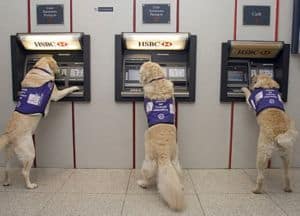The urine sugar Diastix readings are actually very accurate for diabetic pets. In fact, before home blood monitors became available they were used exclusively for owners to monitor sugar levels and insulin dosages.
Today Diabetes is Big Business! The number of pets and people affected with diabetes has sky rocked to epidemic levels. Fortune 500 corporations and pharmaceutical companies including Intervet/Schering-Plough are cashing in and making big bucks by selling all kinds of new diabetes supplies and devices. Relabeling Vetsulin for pets and selling home blood monitors to diabetic pet owners are just two examples of this current trend.
The Diastix urine color readings have to be interpreted and then matched to determined correct insulin dosages for diabetic dogs and cats. Holistic veterinarian, pet expert and author, Dr. Carol Osborne, DVM. is available to work with and teach diabetic pet owners how to monitor and dose insulin for their diabetic pets at home. If you are not able to locate the Diastix, pick up a bottle of Keto-Diastix, also available at Walgreen’s and you will only be using the glucose side of the strip not the ketone side. The outside of the Diastix bottle does not have readings that match the values of -2, -1. Trace, +1, +2 as noted on the pet diabetes article I posted yesterday. This article will show diabetic pet owners how to interpret the colors and values on the Diastix bottle so they can evaluate and interpret their pet’s insulin dosages properly at home by matching the above values.
The outside of the Diastix bottle does have has a series of colors and corresponding percentages. When reading these from left to right, the colors will correspond to the following insulin dosages which you need to make into a chart. Insulin dosages are always calculated from your pet’s previous insulin dosage.
When diabetic pet owners interpret the urine Diastix colors from left to right, the values pet owners need to mark down and date each day or twice a day on their pets urine sugar curve and use to calculate their pets insulin dosage each day are as follows:
- Light Green Color 1/10%: mark -2: which means to reduce your dog’s insulin dose 2 units less than the previous dose. (Urine is negative for glucose)
- Dark Green Color ¼%: mark -1: which means to reduce your dog’s insulin dose 1 unit less than the previous dose. (urine is negative for glucose)
- **Olive Color 1/2%: mark Trace: OUR DAILY GOAL, which means your dog’s insulin dose, is perfect so repeat the previous insulin dose. (Urine is slightly positive (trace) for glucose)
- Light Brown Color 1%: mark +1: which means to increase your dog’s insulin dose 1 units higher than the previous insulin dose (urine is positive for glucose)
- Dark Brown Color 2%: mark +2: which means to increase your dog’s insulin dose 2 units higher than the previous insulin dose. (Urine is positive for glucose)
- Dr. Carol’s Tip: NEVER increase or decrease your dog’s insulin dose by more than 2 units at a time. For cats, never increase or reduce the insulin dose by more than 1 unit at a time.
For diabetic pet owners using the glucose side of the Keto-Diastix your color chart will look like the upper row of colors as pictured here. Do not use the lower colors as those are for ketones which is not of use for us at this time. Here is an example: If your dog’s urine Diastix color reading is dark brown, this means your dog’s urine is positive for sugar and the insulin dose is too low. Dark brown corresponds to the +2 that we marked down on our pets urine sugar chart. Therefore you need to increase the insulin dose by 2 units above the previous dose. For example if you gave your dog 4 units of insulin this morning and tonight the reading is dark brown, increase the dose by 2 units and give him 6 units tonight.
There will be minor fluctuations in sugar readings which in most cases are directly related to what, how much and when your diabetic pet was fed. Treats are another major factor that alters blood and urine glucose levels and your pet’s insulin requirements. The more consistent diabetic pet owners can be as far as what and when you feed your pet, the more consistent your sugar readings and insulin dosages will be as a result.
